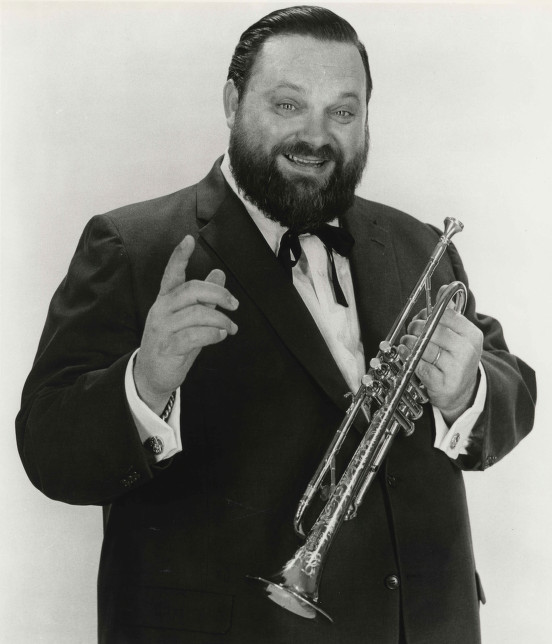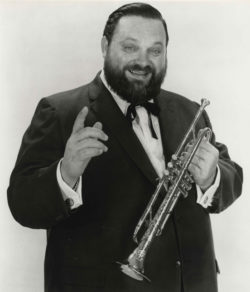Al Hirt
Al Hirt was a New Orleans trumpeter and bandleader was one of the most successful instrumental recording artists in the 1960s.

Courtesy of Louisiana State Museum
Al Hirt. Unidentified
A trumpeter of remarkable technical virtuosity and power, Al Hirt excelled in classical, jazz, and popular genres. Though he saw himself as a “crowd pleaser” rather than a “trailblazer,” Hirt was honored with twenty-one Grammy nominations; he won one award for the bestselling song “Java” in 1964. During his more than six decades as a professional musician, Hirt performed for six presidents, Princess Grace of Monaco, Pope John Paul II, and thousands of adoring fans. His career also included three hits that made Billboard magazine’s Top 40 play list: “Sugar Lips,” “Cotton Candy,” and “Java.”
Early Life
Born in New Orleans on November 7, 1922 to Alois Hirt, a police officer, and Linda Guepet Hirt, Alois Maxwell Hirt made his musical debut on the stage of the Saenger Theater at age six with the Junior Police Band. He studied music at Jesuit High School, and by the time he was thirteen had a reputation as a child prodigy specializing in the classics. Ironically, Hirt’s first interest in jazz did not come in New Orleans at all. In 1940 he won a scholarship to study trumpet formally at the Cincinnati Conservatory of Music, and he later recalled that it was while in the North that he first began to take jazz seriously.
Recording and Touring
After returning to New Orleans in 1942, he spent four years in the Army Air Force as a bugler before resuming his musical career with the big bands of Benny Goodman, Jimmy Dorsey, Tommy Dorsey, Ray McKinley, and Horace Heidt. While traveling with Heidt’s “Stars on Parade” revue in 1950, he made his first recordings for the Magnolia label, taking initial steps along a path that would lead to twenty-one Grammy nominations and a Grammy award for best non-jazz instrumental in 1964 for his rendition of “Java” by Allen Toussaint and Alvin “Red” Tyler, as well as four gold and one platinum long-play albums. His recording career grew slowly, from Magnolia to Southland to Audio Fidelity and then to RCA Victor, but once he gained momentum, the trumpeter went straight to the top. From 1963 to 1965, Hirt’s Honey in the Horn album (from which “Java” was taken) remained on the Billboard charts for 104 weeks, augmented in quick succession by million-selling singles for “Sugar Lips” and “Cotton Candy” in 1964.
Taking the show on the road was also a part of Hirt’s identity and, when he did tour, the critics took notice. Before his recording successes in the mid-1960s, Hirt had already established himself not only as a major tourist attraction in his hometown, but also as an ambassador of the best in New Orleans jazz to audiences in Chicago, Las Vegas, and New York City. His first appearance on the Ed Sullivan Show in 1955 provided a degree of national exposure, and the four to six weeks of annual touring that he permitted himself were organized to provide maximum impact. In November 1960 his critically acclaimed performances at the Dunes in Las Vegas attracted a star-studded audience that included Lena Horne, Patti Page, Peggy Lee, and Jimmy Durante. Two months later Al found himself playing at the inaugural ball of President John F. Kennedy, an event that he never forgot because the president worked his way through a crowd of four thousand people in order to shake he trumpeter’s hand.
Life in New Orleans
Al Hirt was a typical New Orleans home boy, preferring to spend less time on the road touring and more time at home fishing or immersing himself in the Big Easy lifestyle. His love for local cuisine was legendary—he described it as his second passion— and it was apparent in every nickname that was ever bestowed upon him. In the 1960s he opened his own nightclub in the French Quarter, Al Hirt’s Night Club at 501 Bourbon. Ellis Marsalis was his pianist for six years there, and Hirt gave Ellis’s son, Wynton, his first trumpet. His commitment to playing for tourists faltered when he closed the club in 1983, complaining that the Quarter had gotten “kinda rowdy.” He returned to Bourbon Street after only a few years’ hiatus and continued to perform there almost until his death in 1999.
Hirt was a hometown hero, but with mixed benefits. He was an original investor in the New Orleans Saints in the late 1960s (as well as their musical director), but he sold off his 2.5 percent share at a loss only weeks before Tom Benson bought the team for $70 million in 1985. In November 1969, he was presented an award by Governor John McKeithen at a testimonial dinner in his honor at the Roosevelt Hotel but was upstaged when Fats Domino arrived late from Las Vegas wearing a rhinestone dinner jacket with matching shoes. The trumpeter’s combination of girth and celebrity also made him something of a target. During Carnival 1970, Hirt’s lip was seriously injured when he took a brick to the mouth while riding with the Bacchus parade in Central City. Apparently, he didn’t hold a grudge against the krewe, however, because a decade later, he and his friend and fellow musicians Pete Fountain reigned as dual monarchs in the Bacchus parade.
After his death on April 27, 1999, Archbishop Philip M. Hannan came out of retirement to preside at the funeral mass, and the New Orleans Mayor, Marc Morial, ran a testimonial in the Times-Picayuneat his own expense. In 2000 the New Orleans Jazz and Heritage Festival selected the local artist George Rodrigue’s posthumous portrait of Al Hirt as their festival poster. Reflecting upon his accomplishments, he was a model of humility: “ I tried to improvise for a while, but I’m no trailblazer. I look upon myself as a crowd pleaser. I play what the people want to hear … I just want to be remembered as a decent person and a good trumpet player. That would be a good epitaph for me.” Remembered fondly as “Jumbo” to friends and fans alike, Al Hirt remains a musician whose legacy looms large in both sound and spirit.
Adapted from Louisiana Cultural Vistas Magazine, Fall 2010.
